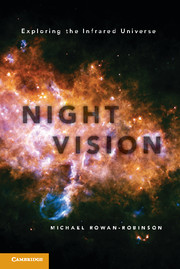Book contents
- Frontmatter
- Contents
- Preface
- 1 Introduction
- 2 William Herschel Opens Up the Invisible Universe
- 3 1800–1950
- 4 Dying Stars Shrouded in Dust and Stars Being Born
- 5 Birth of Submillimetre Astronomy
- 6 The Cosmic Microwave Background, Echo of the Big Bang
- 7 The Infrared Astronomical Satellite and the Opening Up of Extragalactic Infrared Astronomy
- 8 The Cosmic Background Explorer and the Ripples, the Wilkinson Microwave Anisotropy Probe and Dark Energy
- 9 Giant Ground-Based Near-Infrared and Submillimetre Telescopes
- 10 The Infrared Space Observatory and the Spitzer Space Telescope
- 11 Our Solar System’s Dusty Debris Disk and the Search for Exoplanets
- 12 The Future
- Epilogue
- Notes
- Credits for Illustrations
- Glossary
- Further Reading
- Bibliography
- Name Index
- Subject Index
2 - William Herschel Opens Up the Invisible Universe
Published online by Cambridge University Press: 05 March 2013
- Frontmatter
- Contents
- Preface
- 1 Introduction
- 2 William Herschel Opens Up the Invisible Universe
- 3 1800–1950
- 4 Dying Stars Shrouded in Dust and Stars Being Born
- 5 Birth of Submillimetre Astronomy
- 6 The Cosmic Microwave Background, Echo of the Big Bang
- 7 The Infrared Astronomical Satellite and the Opening Up of Extragalactic Infrared Astronomy
- 8 The Cosmic Background Explorer and the Ripples, the Wilkinson Microwave Anisotropy Probe and Dark Energy
- 9 Giant Ground-Based Near-Infrared and Submillimetre Telescopes
- 10 The Infrared Space Observatory and the Spitzer Space Telescope
- 11 Our Solar System’s Dusty Debris Disk and the Search for Exoplanets
- 12 The Future
- Epilogue
- Notes
- Credits for Illustrations
- Glossary
- Further Reading
- Bibliography
- Name Index
- Subject Index
Summary
William Herschel (Figure 2.1, Plate II) was one of the greatest astronomers of all time, certainly the greatest since Galileo. His achievements dominated his age in a way that did not happen in the twentieth century, even though there have been some great astronomers in our time. Herschel discovered the first new planet in recorded human history, Uranus; constructed telescopes of a size and quality which were unrivalled in his day; demonstrated the disk-shaped structure of our Milky Way Galaxy; and surveyed the whole northern sky for nebulae and demonstrated that many were star clusters. He showed that the universe was enormously larger than had previously been imagined and introduced the idea that stars are born and die. He thought that some nebulae might be distant star systems similar to the Milky Way, but later doubted this. But above all Herschel discovered that the Sun emits radiation beyond the red end of the spectrum – infrared radiation – and thereby opened up the astronomy of the invisible wavelengths that has been a dominant feature of astronomy since 1960.
Remarkably Herschel was an amateur, self-taught astronomer, and might have remained an obscure amateur but for his discovery of Uranus. His father was a bandsman in the Hanoverian army who also loved astronomy and who imparted his love of music and astronomy to his children. In due course, at the age of fourteen, William also became a bandsman, and father and son later campaigned with the Hanoverian Foot-Guards in the War of the Austrian Succession. Following the French occupation of Hanover, Herschel’s parents were concerned about William’s safety, so in 1757 they got him out of the army and sent him to England, at age eighteen, to seek his fortune as a musician.
- Type
- Chapter
- Information
- Night VisionExploring the Infrared Universe, pp. 15 - 22Publisher: Cambridge University PressPrint publication year: 2013



